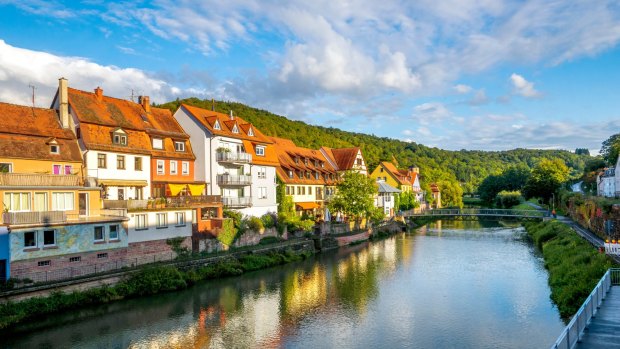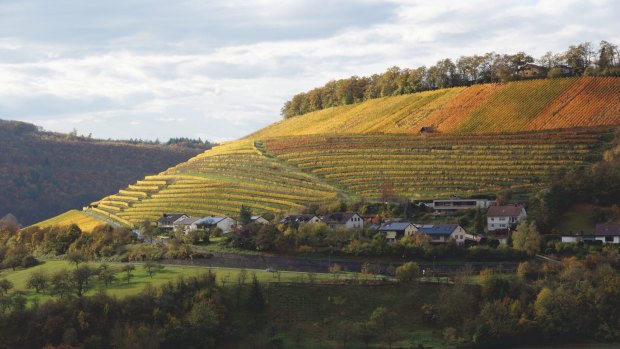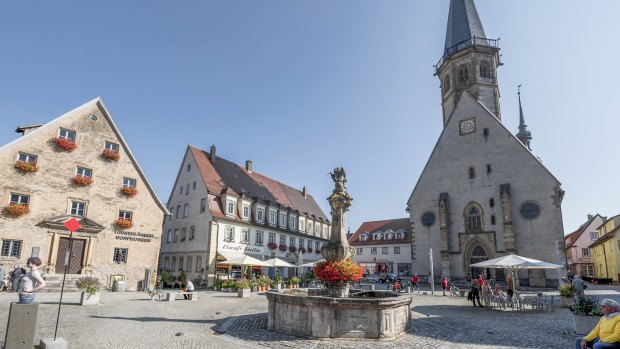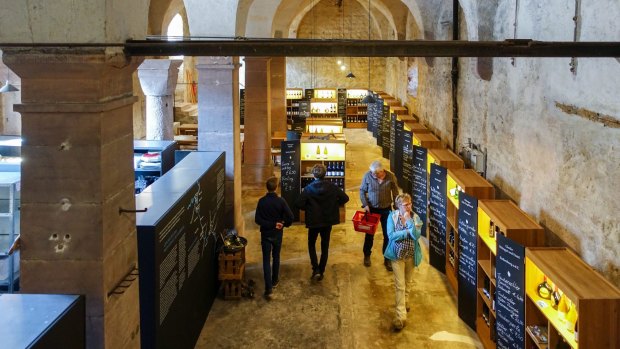This was published 5 years ago
Tauber Valley, Germany: The valley the tourists forgot

Wertheim-am-Main, in the Tauber Valley, wears its history like a well-worn coat.
There are worse things in life than touring pretty vineyards with a buxom winemaker called Conny, who wears lederhosen and a chequered red blouse, occasionally breaks into song, and feeds you her own baked bread studded with almonds. It's a happy start to the Tauber Valley, a gentle fold in the landscape of south-west Germany that I first spy from the medieval walls of Rothenburg-ob-der-Tauber, one of Bavaria's busiest tourist honeypots.
The Tauber Valley makes its escape from here across the border and into Baden-Wurttemberg, a German state few foreigners could name. For some reason, the tourist hordes don't follow. They get back into their tour coaches at Rothenburg and head off to the next Big Thing, and so miss the very nice small thing that is this valley, which wiggles its way past pretty but unassuming towns and through a rolling landscape of neatly pegged vineyards and forest.
The Tauber River flows for only 132 kilometres before it joins the Main River an hour south-east of Frankfurt. For centuries, though, it has been crisscrossed by kings, armies and merchants on the road between Frankfurt and Vienna, and the Main and Danube rivers. The result is a dense legacy of castles, trading towns and monasteries. It's easy to get to but, like a wrinkle in space-time, is now bit old-fashioned and a bit somewhere else.

Autumn colours the vineyards in the Tauber Valley.Credit: Shutterstock
I encounter Conny Lehr in Markelsheim, a red-roofed town enfolded in vineyards. Most of these vineyards are less than a hectare in size and have no cellar doors, so I head instead to Weingartner Markelsheim, a wine collective that brings together the creations of some 250 producers. The most cultivated grape variety is silvaner, and it's a good chance to try the regional output, which is fresh and fruity, with a medium acidity and a typical mineral note from the limestone soils. Many claim the Tauber Valley produces Germany's best silvaner wine.
"It's the best silvaner in the universe, actually!" Lehr announces, later. "It's the kind of wine you can drink even when you aren't thirsty."
I'm on a wine-tasting tour around Markelsheim's vineyards with Lehr, who owns 5½ hectares of vines and a farm that grows wheat and corn. She pulls her happy guests in a custom-made carriage behind a tractor, and now and then stops to play the accordion. Everyone sings rousing German drinking songs. We trundle past four of her huge wine barrels on the hillside, converted into cabins where you can stay the night. For those who'd rather explore on foot, a three-kilometre wine hiking circuit runs right in front of their chintz-framed windows.

Weikersheim's central square.Credit: Shutterstock
Lehr loves her silvaner but is even more excited about the heritage grape variety tauberschwartz, which she explains was rediscovered growing in a private garden in 1996, and is now revived on just 12 hectares of vineyards. It's a very fruity grape with mild acidity that makes a light red wine, a somewhat stronger aged alternative, or a sparkling summer rosé.
"With this wine, you will have romantic candlelit moments!" claims Lehr, before cranking up her accordion once more.
There's a gentle, unassuming romance to this entire little valley. Around Markelsheim, the Tauber opens out into fields of bright yellow rapeseed and more vineyards, the modest river glinting beneath an overhang of willow trees below. Passing towns huddle around steep-spired churches and striped maypoles topped by fir branches. The seeming rural isolation springs surprises, however. In Weikersheim, a flamboyant Renaissance palace bursts with wood carvings and stuffed deer heads. Formal baroque gardens of gaudy parterres and splashing fountains are magnificently framed by the borrowed hills of its background. Statues of Greek goddesses frolic, and balustrades are topped by comic stone dwarfs.

Bronnbach Monastery's wine cellar.Credit: Alamy
Further up the road from Markelsheim, I arrive in Bad Mergentheim, a spa resort developed in the 19th century around mineral springs whose bitter, salty water is said to be good for digestive ailments. It faded somewhat after World War II but, while it might have lost its cachet, it has retained lovely spa gardens flanking the Tauber River under giant oak and chestnut trees.
Flowerbeds are a riot of colour, leading me onwards to Japanese and rose gardens and bubbling fountains. I take a seat in the Gradier Pavilion, where spring water trickles through brushwood walls, creating a cooling, salty breeze. Then I wait for the spa orchestra to make an appearance in the music pavilion. It runs through light classics, timed with a choreographed sequence of fountain jumps and splashes. It's entertainment from another era, genteel and delightful.
I drive north to Tauberbischofsheim, which translates as "home of the bishop of Tauber". The town's old walls have gone, but many of its half-timbered houses remain, leaning against each other around a market square and guarded by a watchman's tower. The bishop's castle is a Rapunzel fantasy of gnarly stone and pointed roofs. Cyclists in Lycra rewards themselves with beers here on their way along one of Germany's best cycle paths, which runs for 101 gentle and very scenic kilometres through the Tauber Valley, conveniently anchored at either end by train stations.
I rise early to be greeted with mist on the river, where swans paddle sedately and herons strut. Golden weathervanes glint on church spires and immaculate riverside villages are just stirring. The smell of bread rolls wafts from bakeries. I stop off at Bronnbach, a Cistercian monastery begun in the 12th century, though its chapel and hall are both outrageously baroque, with eruptions of plaster cupids and gaudy frescoed saints.
Monks were never far from a good drink. Their cellarium is now a venue for wine tasting, my chance to try some more of the region's unusual grape varieties such as kerner and scheurebe (both whites) and the reds domina and lemberger. The white wine comes with slices of cheese sprinkled with finely chopped onion in vinegar.
My journey ends at Wertheim-am-Main, a place that wears its history like a well-worn coat. The old town is a squeeze of half-timbered houses, quaint fountains and votive murals, topped by a semi-ruined castle that guards the confluence of the Tauber and Main rivers. My little valley ends here, though the Main is lovely, too. Soon I'll be coughed up again into the tourist mainstream with a sigh.
TRIP NOTES
Brian Johnston travelled courtesy the German National Tourist Office and Romantic Road.
MORE
FLY
Etihad flies to Abu Dhabi and Frankfurt , a one-hour drive from Wertheim. Phone 1300 532 215, see etihad.com
TOUR
The Romantic Road Express coach links the major sights and towns of this tourist route, including the Tauber Valley, and connects to Frankfurt and Munich airports. See touring-travel.eu
STAY
Markelsheim winery Jakobshof has romantic rooms inside converted wine barrels with stunning views over the Tauber Valley and its vineyards. You can use pool and wellness facilities at a nearby hotel. The family also runs amusing wine tours on the back of a tractor. See jakobshof-lehr.de. Hotel Schwan near the riverfront in Wertheim is short walk into the old town and has both an historic and new wing. See hotel-schwan-wertheim.de.
Sign up for the Traveller Deals newsletter
Get exclusive travel deals delivered straight to your inbox. Sign up now.